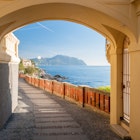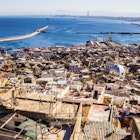

Save money on your visit to Morocco with these budget tips © Thomas Barwick / Getty Images
Morocco offers excellent value for travelers of all budgets.
Rest assured, you'll be offered a warm welcome and authentic hospitality regardless of what you spend. Take some time to learn a few basic Moroccan Arabic phrases to connect with locals, and discover the value that comes from something being real and priceless.
Here are our top tips to make your money go further on a visit to Morocco.
A guide to daily costs in Morocco
Bed in a shared hostel room: 100–250 MAD
Basic room in a riad for two: 300–600 MAD
Self-catering one-bed apartment (including Airbnb): 400 MAD
Public bus/tram ticket: 5 MAD
Coffee/mint tea: 10–30 MAD
Sandwich: 30–50 MAD
Dinner for two: 200–500 MAD
Beer/pint at the bar: 50 MAD
Average daily cost: 1000 MAD per day for 2 people.

1. Do your accommodation research online in advance
Accommodation in Morocco is affordable compared to Europe or North America, and the value for money is often much higher. There are plentiful budget accommodation options, from hostels to homestays. For those with more to spend, charming riads and luxury palatial hotels are well-priced and offer a memorable experience. Book ahead during high season (November to March), as well as the period around Easter. Most properties will be listed on booking.com and nowadays a growing number of private rentals are bookable on Airbnb. Some hotels offer discounts for direct bookings.
2. Take your breakfast out
If you're in a city, consider opting out of your accommodation breakfast and venturing instead to a local cafe for a cheaper deal. A variety of breakfast menus are usually available until midday. A typical breakfast of fresh orange juice, a hot drink, Moroccan pastries, eggs and homemade bread is 30–50 MAD per person.
3. Experience local life with a meander in a medina
There's no better way to soak up the history and heart of a Moroccan city than pottering in its medina. The historic centers of Fez, Marrakesh, Rabat, Essaouira, Tangier and Meknes are well-preserved, thriving, and completely free to visit. Be spellbound by the pastel blue streets of the charming blue city of Chefchaouen perched high in the Rif Mountains. Join people going about their daily life, get lost in the myriad alleyways, take in the fix-this-and-that stores, seasonal juice stands, homes alongside guesthouses, and observe artists at work using ancient craft techniques. Or, just enjoy the freedom of wandering without purpose or plan.
4. Internal flights are good value
Morocco is bigger than most people think, and if you're combining the north, south, and/or Sahara on one itinerary, it may be worth taking an internal flight. Royal Air Maroc and Air Arabia have a good network catering to a rise in demand, and for longer journeys, it can feel a bit like hopping on and off a coach, with prices to match. There are a couple of routes that are good money-savers. Casablanca to Zagora (one of the access points to the Sahara) is a 2-hour flight (from 400 MAD one way) or a 9-hour non-stop/600km drive. Casablanca to Dakhla in the far, far south, costs from 900 MAD one way for a 2-hour flight or is a 20-hour drive (1600km).

5. There are ways to see Marrakesh on a budget
Marrakesh has been welcoming travelers for many years, and has evolved into a city that caters for all budgets. There are a number of free experiences in the city too.
When booking accommodation in Marrakesh, a few things to consider are that some hotels include private airport transfers (150–200 MAD one way) in their rates; a saving on money and hassle. There is also a new taxi booking system at the airport, buy your ticket at the counter before exiting Arrivals. The price goes up after 9pm. The cheapest way to travel is on the Alsa bus from the airport to Djemma el Fna (30 MAD).
July and August are low season with some hotels offering 20% off rates. With an average temperature 35–40°C (95–104°F) it's not for everyone, but if there's a shaded swimming pool, air-conditioning, gardens and spa available, it could be perfect!
Among the most popular and expensive attractions are the Yves Saint Laurent Museum and Jardins Marjorelle. Hop online and purchase a combined entry ticket in advance – you'll save queuing time and money if you qualify for their generous discount options (children under 10 go for free).
Less expensive places to visit include the Badia Palace, Bahia Palace and Saadian Tombs. Read up on the history beforehand if you want to visit without a guide.
6. See archaeological sites for less, or free
Morocco is full of historic surprises with ancient ruins and century-old civilizations, many without crowds or steep entry fees. Morocco's nine Unesco Heritage Sites include the free-to-visit medinas of Marrakesh, Fes and Essaouira. Perhaps lesser-known are the impressive Roman ruins at Volubilis, considered to be the best-preserved archaeological site in Morocco, which you'll pay an entry fee of 70 MAD to see. Ksar Ait-Ben-Haddou, a striking example of architecture in southern Morocco, is a village that is open to the public with no entry fee required.
7. Use your card wisely and carry cash
The Moroccan dirham is a closed currency which means you cannot use or get it outside Morocco. When you withdraw dirhams from ATMs in Morocco, they usually charge a transaction fee of 25–30 MAD per withdrawal for international cards regardless of the amount. So consider withdrawing as much as you are comfortable to carry, and using your card for purchases when offered. Contactless card payment works in most larger establishments in cities and towns. Keep small change handy: 1, 2, 5 and 10 dirham coins are useful for tips and small notes 20, 50 and 100 dirham notes for small purchases.

8. Eat your heart out with inexpensive meals
Food plays a big part in Moroccan culture, and if you go where the locals go, it's accessible and inexpensive. Tasty street-food is served up in stalls all over. At a simple roadside cafe you can pick up a sizzling tagine for around 40 MAD. At the other end of the scale, there are plentiful fine-dining experiences offered in major city restaurants, with innovative chefs serving up main courses that would be two to three times more expensive in other countries for around 150–200 MAD.
If you are self-catering or picking up snacks, check out the fruit and vegetable souk – there's one in every neighborhood. Prices are usually discounted towards the end of the day, and if you really like to get the best price, ask for the price per kilo and shop around different vendors. Shopping for meat, check out the local butchers, easily recognized by their red-and-white paint with their fresh cuts hanging out front. Ask for the amount of meat you want by weight, in dirhams, or by the number of people you are cooking for.
9. Have a hammam scrub
Nothing beats a scrub down and relaxing massage after a long day of sightseeing and the popular and traditional Moroccan hammam experience that can be enjoyed at all budget levels. Hammams can be found all over, from a simple steam and scrub at a no-frills public bathhouse costing around 10 MAD to a private hammam at a luxury spa (expect to pay 250–400 MAD) with mud masks and massages (200–350 MAD for 60 minutes) on offer too.
The cheaper public hammams look like a public toilet or swimming baths from the outside and they don't tend to be well signposted from the street. There will be two separate entrances: one for men and one for women. There's no private room or luxury ritual on offer here – the public hammam is about bathing with the masses, and the budget prices reflect that.
10. Connect with a local network for mobile savings
There's a good 4G/5G network across Morocco, except for some far-flung rural areas. Calls and internet roaming can be very expensive on international networks so consider buying a prepaid Moroccan mobile SIM card at the airport on arrival. During your stay you can top-up directly with local network providers (Inwi, Maroc Telecom and Orange) on their websites. WhatsApp and WhatsApp location are used to organize most things in Morocco.
Electronic devices and imported items are usually more expensive if purchased brand new in Morocco versus Europe or North America, so bring what you need and take care of them. Having said that, it is easy to get repairs and secondhand ones in many souks.
11. Public transportation costs are reasonable
In northern Morocco, there is an excellent rail network linking the cities, with affordable prices and a punctual service, including Africa's first high-speed train, Al Boraq. The 2-hour journey (from 130 MAD one way in first class) makes it possible to visit Tangier on a day trip from Casablanca. Book in advance on the ONCF website, or at a train station. Discounts are available depending on fare availability.
A comfortable and reliable coach network is operated across the country by Supratours and CTM, linking most cities and towns, north and south. Alsa is the bus operator within the cities and towns and a single fare costs 5 MAD. Rabat and Casablanca also have user-friendly tramway systems with similar prices to the bus.
Petit taxis (their color varies depending on the city) are taxis that can only travel within the city limits. There's no haggling or set prices here – the fare is determined by the meter.
Grands taxis are a quick way of getting between towns without using regular public transport. You can pay for one seat or buy them all if you want private use. Agree the price with the driver before you get in.
12. Car hire is cheapest at the airport
Vehicle hire is obviously going to eat into your budget significantly. You can usually find the best rates (from 300 MAD per day) when you pick up and drop off at the same airport where a number of international car rental agencies are located. Autoroutes are toll roads and you will need to pay to use them. Save a little time at the toll booths by buying a Jawaz Pass – you can top it up online and pass through the dedicated lanes.
Morocco lends itself well to van life with plentiful free wild camping opportunities and designated campsites with low rates. Campers or motor homes can be hired from Zig Zag Campers, and cheap overnight parking options can be found on Park4night.
Explore related stories






 Tips & AdviceCapital One transfer partners: the most valuable options for 2024
Tips & AdviceCapital One transfer partners: the most valuable options for 2024Sep 4, 2024 • 14 min read




